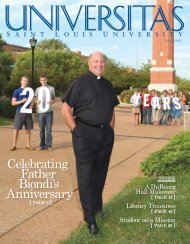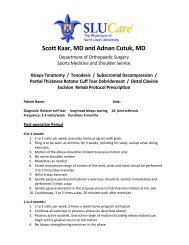The effects of third-order torque and self - Saint Louis University
The effects of third-order torque and self - Saint Louis University
The effects of third-order torque and self - Saint Louis University
You also want an ePaper? Increase the reach of your titles
YUMPU automatically turns print PDFs into web optimized ePapers that Google loves.
optimal clinical results. Fixed-appliance therapy involves<br />
at least some relative (mesiodistal) wire-slot displacement<br />
in various phases <strong>of</strong> treatment; hence, the generation <strong>of</strong><br />
friction during tooth movement can be problematic for the<br />
orthodontist. Because a portion <strong>of</strong> the force for delivery<br />
to a tooth-crown to be displaced may be necessary to<br />
overcome frictional resistance, the orthodontist must be<br />
sure to use a force <strong>of</strong> sufficient magnitude to also<br />
initiate a biological response in the supporting tissues. 4<br />
<strong>The</strong> application <strong>of</strong> sliding mechanics in orthodontics<br />
has increased since the introduction <strong>of</strong> the pre-adjusted<br />
edgewise appliance system. 5 <strong>The</strong> process can involve the<br />
guidance <strong>of</strong> a tooth along a continuous archwire or the<br />
movement <strong>of</strong> the wire through the crown-attachment slot(s).<br />
In particular, overjet reduction <strong>and</strong> space closure have<br />
been traditionally accepted applications <strong>of</strong> sliding<br />
mechanics. In a first premolar extraction case, a space is<br />
created between the canine <strong>and</strong> the second premolar. When<br />
maximum anchorage is desired, the canine would first be<br />
retracted bodily with the archwire guiding its<br />
displacement. This single tooth movement would likely<br />
create unwanted friction that could cause “side <strong>effects</strong>”<br />
such as uncontrolled tipping, loss <strong>of</strong> posterior anchorage,<br />
or deepening <strong>of</strong> the overbite. 6 Forces acting posteriorly on<br />
51
















